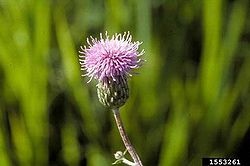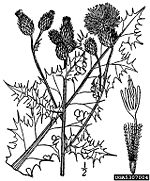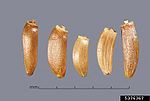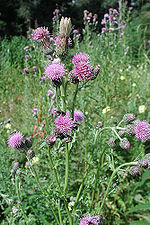Canada thistle
| Canada thistle |
|---|
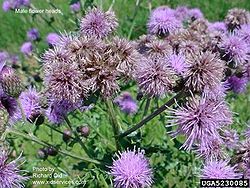
|
| Scientific Classification |
|
| Binomial Name |
|
Cirsium arvense |
| thistle flower head |
The Canada thistle is a species of thistle with the scientific name Cirsium arvense. It is also known as the Scottish thistle, Californian thistle, creeping thistle, corn thistle, perennial thistle, and field thistle. The plants native origin is yet to be distinguished because the plant has spread to Japan, China, Canada, and North America. It is considered a "noxious weed" and it is difficult to get rid of. It has a self regenerating and as well as sexual reproductive system.
Anatomy
The Canada thistle grows up to one and a-half to four feet tall. The root system is widespread and reproduces whenever attempts are made against it. Vegetated buds that are contained in the root system help the plant reproduce. The stems of the Canada thistle are sort of hairy, ribbed, and branched. [1]The leaves are various in size, oblong in length, and at least three to five times the width of the leaf. The color of the leaves are a rather dark shade of green, with tooth-like or spiny edges. The flower heads of the Canada thistle appear as the shape of an umbrella. They can range in color from pink to rose-purple to purple to a light lavender; the thistle is even known to come in white. The stem of this plant is green, but it can even be lavender. [2]
Reproduction
The Canada thistle flowers in late spring to early summer. The plants are dioecious (separate male and female plants) and grows in a circular pattern. The Canada thistle is the only flower to grow as separate male and female groups. The female flowers create a sweet fragrance that can attract insects that pollinate different sexed patches from up to two hundred feet apart from each other.[3] The male plant is slightly smaller than the female. The flowers are about one inch in diameter. [4] Seeds are viable for up to ten days after flowering. The fresh seeds germinate immediately or remain dormant for three years. Each flower head can produce up to eighty seeds [5], and each flowering shoot can produce up to one thousand to fifteen hundred seeds. The seeds are transported by water, animals, clothing, wind, and other vehicles. The seed is viable for twenty-two years and can survive longer through deep burial. [6] The Canada thistle underground root system grows to a depth over ten feet, resulting from a growth of twelve to fifteen feet per year. Root shoots appear on the root buds whenever weather conditions are favorable. [7]. Roots continually replace old and weak roots. The roots regenerate from small pieces and have a rapid horizontal growth. [8]
Ecology
The Canada thistle is a type of creeping perennial weed that can be aggressive. This type of weed infests crops, pastures, rangeland, roadsides, and even in non crop areas. An infestation of this plant can start in areas like ditch banks or overgrazed pasture. [9]
It is invasive in these United State areas: AK, AZ, CO, CT, DE, IA, ID, MD, MI, MN, MO, MT, ND, NJ, OH, OR, PA, RI,SD, TN, VA, WA, WI, WV, and WY. The Canada thistle tends to grow best in moderate temperatures and rainfall of North America. The rosettes need at least fourteen hours of sun to flower. When the temperature exceeds eighty-five degrees Fahrenheit, the thistle stops growing. The roots will grow deeper in clay or muck type soils. These roots are known to have some medical properties, like treating mouth disease. [10]
The Canada thistle is a common pest throughout the areas it infests and is often difficult to control. Biological control of the Canada thistle has had little success. One insect, the seed weevil Rhinocyllus conicus, was able to stop eighty percent of seed production. The larvae developed inside the flower head and eat the seed as it grows. Unfortunately the weevils preferred the earlier blooming flowers. The late bloomers go undamaged and produce their seeds. Another weevil, the Trichosirocalus horridus, was next to control the thistle by eating on the plant’s apical meristem of the rosette and developing stems. Even with both insects feasting on the plant, the Canada thistle is only partially controlled. A third weevil, the Ceutorhynchus litura, was accidentally introduced, and it controls the thistle on a larger scale than the previous two weevils. The larva of this weevil eats the underground parts. There are many other insects that aide in the biological control of the Canada thistle, but the most effective is the Vanessa cardui or lady butterfly. The only problem is that the lady butterfly is native southern states, like Arizona. The populations only build up large enough for a migration to the north every eight to eleven years. [11]
Control
In North Dakota, the Canada thistle has become quite a pest for crops. Actually the thistle can be a pest problem anywhere. The best way to keep the plant under control is with a herbicide, depending on crop rotation. For this to work, the treatment must continue, with no interruptions, for three years. For small grains, the best herbicides to use are 2, 4-D, MCPA, dicamba, Curtail, Curtail M, Ally,Amber, Canvas, Express, Finesse, and Harmony Extra. Curtal is the most consistent controller, but one dose will not control the thistle completely. Some really good products for Canada thistle control are marked in flax, sugar beet, and corn. [12]
